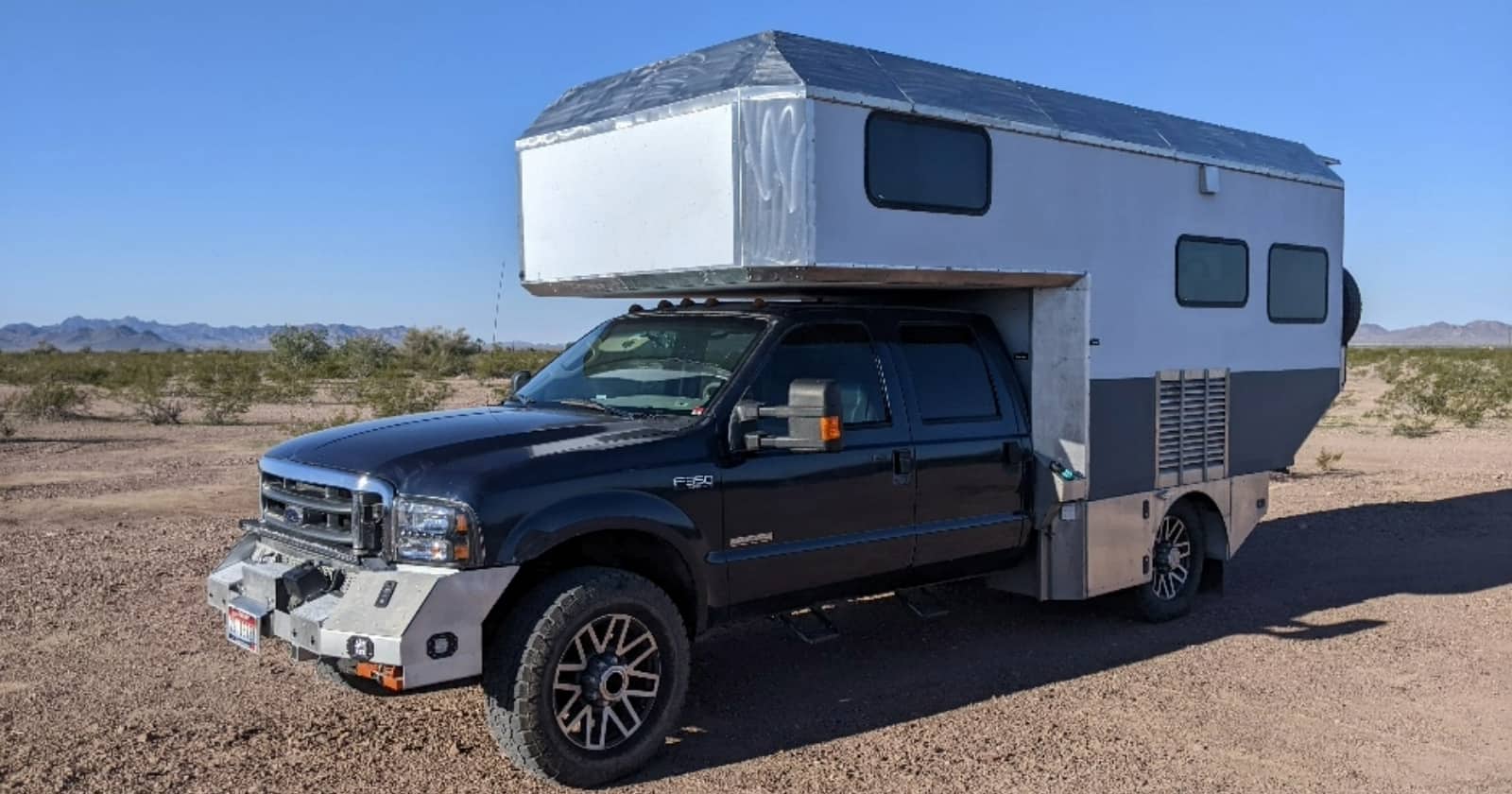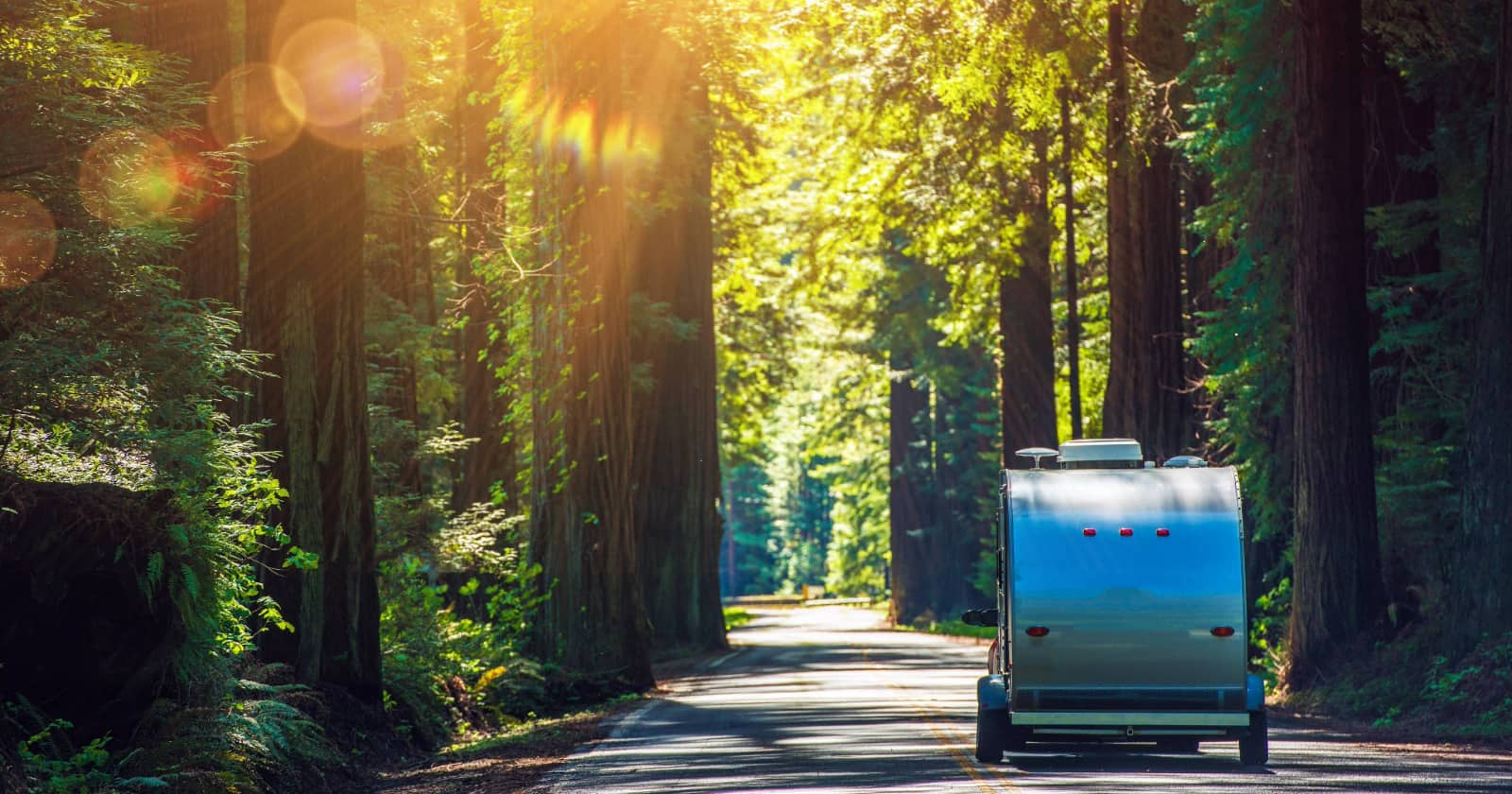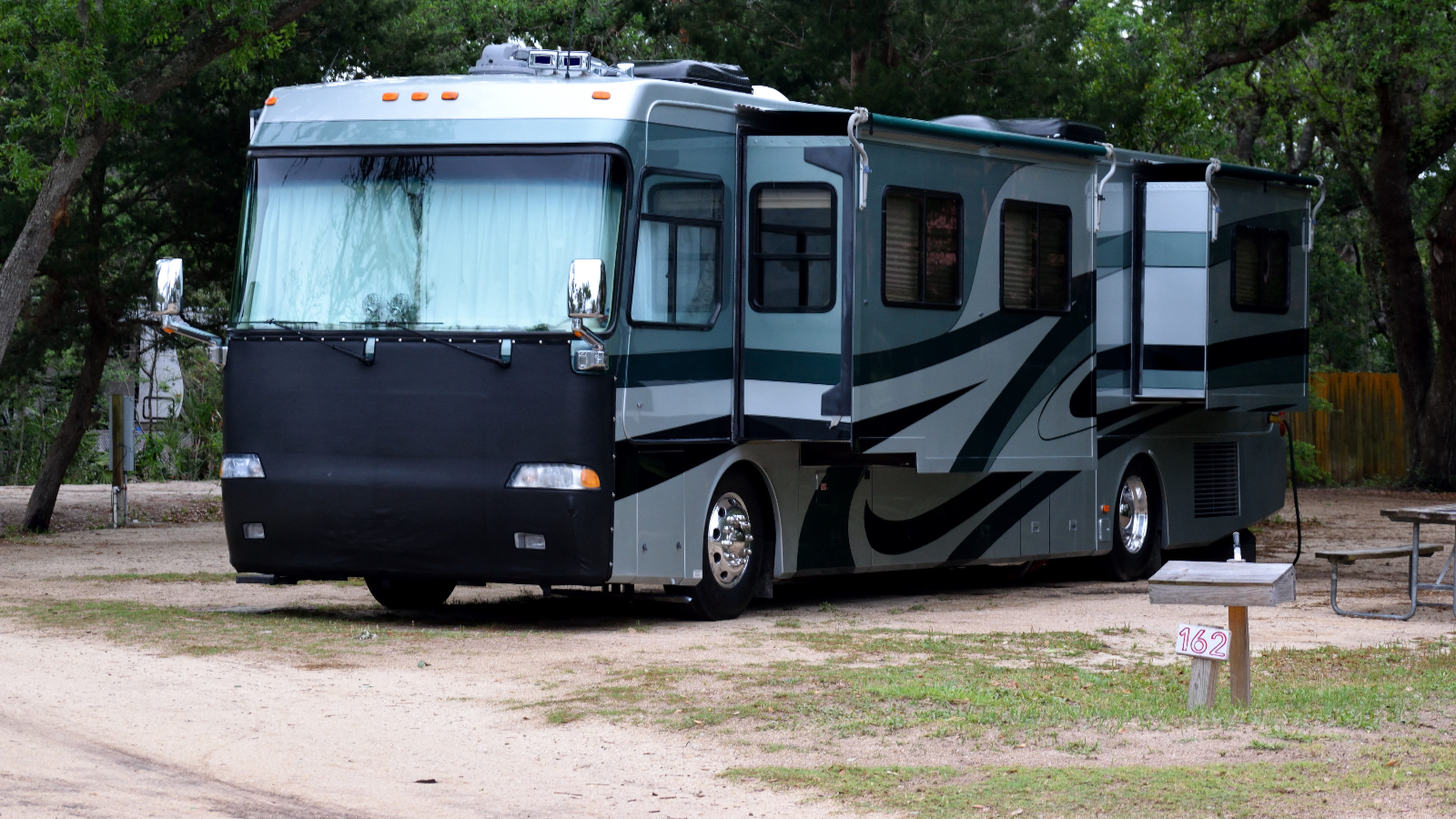
A Complete Checklist Of RV Upgrades And Modifications
Part of the fun of owning an RV is fixing it up to match your travel needs and wants. Even if you purchase a brand new unit with all the bells and whistles, there are usually a few RV upgrades made to help personalize your home on wheels. Regardless if you utilize your RV seasonally or year-round, investing in RV upgrades can make life on the open road more comfortable and stress-free.
RV upgrades encompass improvements in areas like energy efficiency, safety, technology and communication, water conservation, storage capacity, and overall aesthetics. The following is a comprehensive checklist of RV upgrades to consider for your brand new or new-to-you RV.
Improve energy efficiency
Aside from helping the environment, being conscientious about energy consumption and conservation can lower the electric bill and add a few more days onto boondocking stays.
The following are upgrades that can help improve energy efficiency in your rig, including lighting a room, finding alternative forms of energy, and keeping comfortable inside regardless of the weather outside.
LED lights
Replace the halogen or incandescent bulbs in your RV with LED lights. LEDs, or light-emitting diodes, are simple to switch out and come with many advantages. RVshare outlines these benefits including:
- LED lights are energy efficient. They only consume 10% of the power that standard RV lights use. This significantly prolongs the life of your RV batteries.
- They are not harmful in the fact that they do not produce UV light and are mercury-free.
- Yes, LED lights come at a higher price tag, but a single bulb can be used up to 60,000 hours. Compared to their counterparts, which last a total of 1000-2000 hours, LEDs shine in this department.
- Speaking of shine, LEDs are brighter and generate minimal heat.
- Lastly, LEDs are tough and durable in that they were created to not break with the bumps and jolts of an RV in motion.
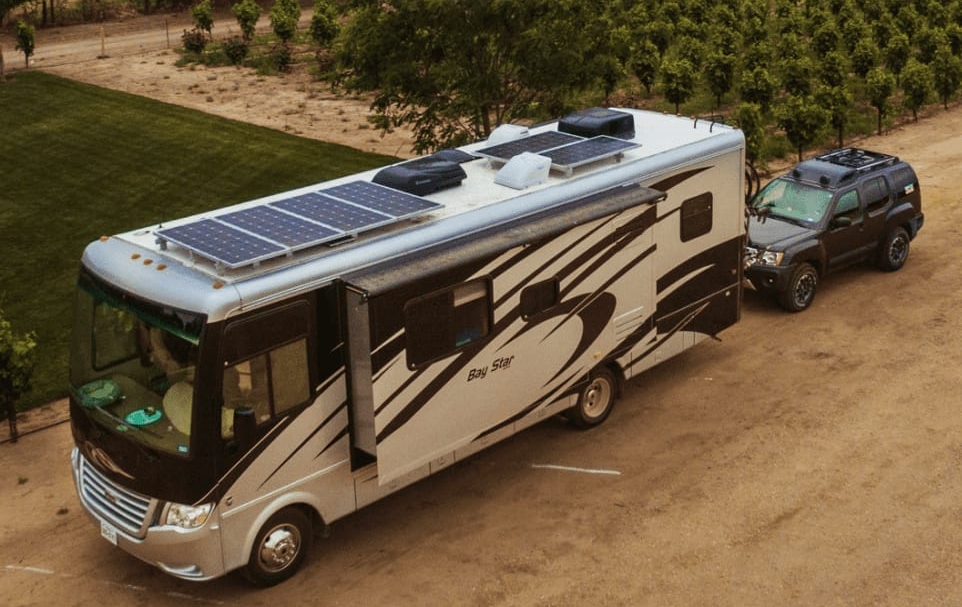
RV Solar Power
If you are an avid boondocker, switching to solar power may be the best route to go, as opposed to relying on a generator. In the long run, despite the upfront costs, it is clean energy, quiet, and will pay off itself and then some. Plus, the cost of solar systems is dropping every year.
A complete solar kit includes panels, a solar charge controller to send the power created by the panels to your RV battery, and an inverter that transforms AC into DC power, power many of your appliances need to run. Steph and Nate Yarbrough of Explorist.life give a detailed explanation of how solar works and how to set up a solar power kit on a truck camper in their video below.
For a more in-depth look at installing a solar power system, check out this series by Ronnie Dennis on every step of the process:
- DIY Solar: What Is It, And Do You Need It?
- Installing A Solar Power System: What Components Will You Need?
- DIY Solar Power: How Much Do You Need?
- How To Install A Solar Panel System On Your RV Roof
- How To Install The Interior Components Of A Solar Power System
Lithium Batteries
Lithium batteries have become a huge hit with RVers, despite their high dollar price. They require zero maintenance and boast a longer life span. Where a traditional lead-acid battery may need to be replaced every 2 to 3 years, a lithium battery would need to be changed every 10 years.
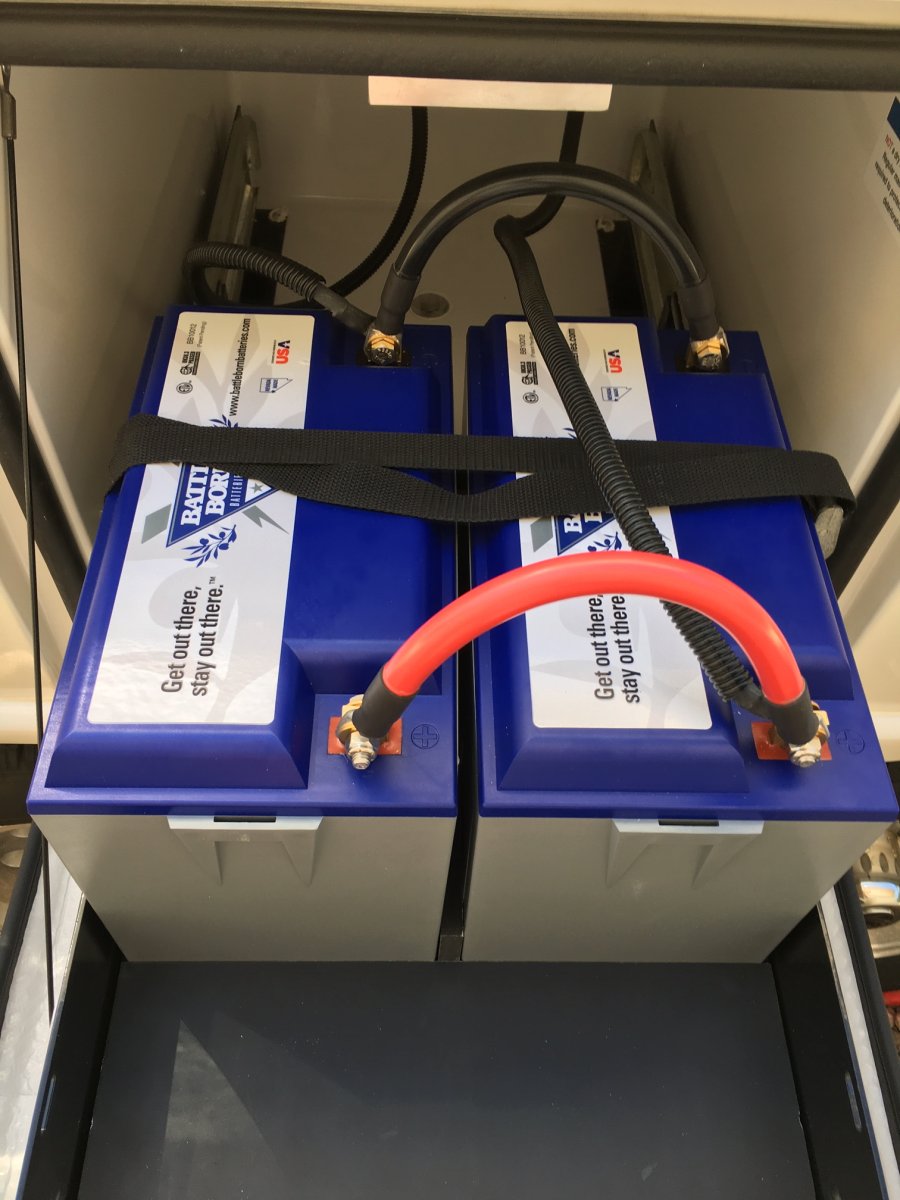
For RVers looking to upgrade to solar power, paying a little more for lithium batteries can capitalize on the efficiency of the system as well. Check out this article from RV LIFE on the benefits of installing them, as well as squashing fears and misconceptions one may have about the product. Camper Report also shares great information in this post.
Insulation
Insulate your RV to keep the inside toasty during the winter and cool during the summer. Investing in a few RV accessories can do the trick to keep temperatures in your RV optimal and electric usage to a minimum.
For example, window covers can help in warmer climates. Covers are placed on the outside of the windows. Sunguard, for instance, makes customized window covers that block anywhere from 85%-100% of the sun’s intense heat, light, and destructive UV rays. (They also make covers for tires, windshield wipers, and dashboards to preserve the life of those parts.) Blackout shades or curtains can make a big difference, helping to regulate interior temperatures, warmer in the winter and cooler in the summer.
Also, investing in custom skirting can help insulate the underbelly of your rig during windy, blustery days. Custom skirting is best left to the professionals, but if you like to camp in cold climates, this is a good investment. RV skirting works much the same way as a windbreaker. It keeps the chill out and keeps the warmth inside.
A/C Soft Starter
An A/C soft starter is a device that prevents the momentarily huge spike of AC motors. It is installed in an RV air conditioner’s compressor and permits the appliance to either ramp up the speed or start softly. This action allows RVers to run one or both AC units on fewer amps or smaller generators.
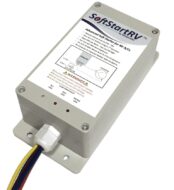
This solves the problem of having a 50 amp RV but only having a 30 amp power source available. RVers can run their A/C or heat pump without tripping breakers. SoftStartRV helps RVers throughout the year, in both the warmer and chillier months. Check out how you can easily install one yourself in the video below.
Enhance Safety Features
RVing is all fun and games until someone gets hurt or valuables get stolen or damaged. Protect your traveling crew and your belongings by incorporating some or all of these RV upgrades. These safety measures are sure to bring a degree of peace of mind on your next outing.
RV Entry Steps
A quality set of RV entry steps is essential to help you and your traveling companions (humans and pets) get in and out of your rig safely. The factory set of RV steps are not always the best option so looking into an upgrade may be your next step.

When choosing the best steps for your needs, consider factors like construction, stability, and compatibility. Installing a longer staircase for uneven terrain or a handrail for additional support are options to ensure another level of safety.
Storage Bay Locks
According to Industrial Lock and Hardware, Inc., “It is estimated that 75% of the recreational vehicles out there share the same key and lock system.”
They are referring to a key marked CH751 used to lock up belongings on RV storage bays. This key is used on most Class A, B, and C RVs. Manufacturers use this universal key-lock system to cut down on production costs. To avoid theft of your precious belongings, it only makes sense to change your locks.
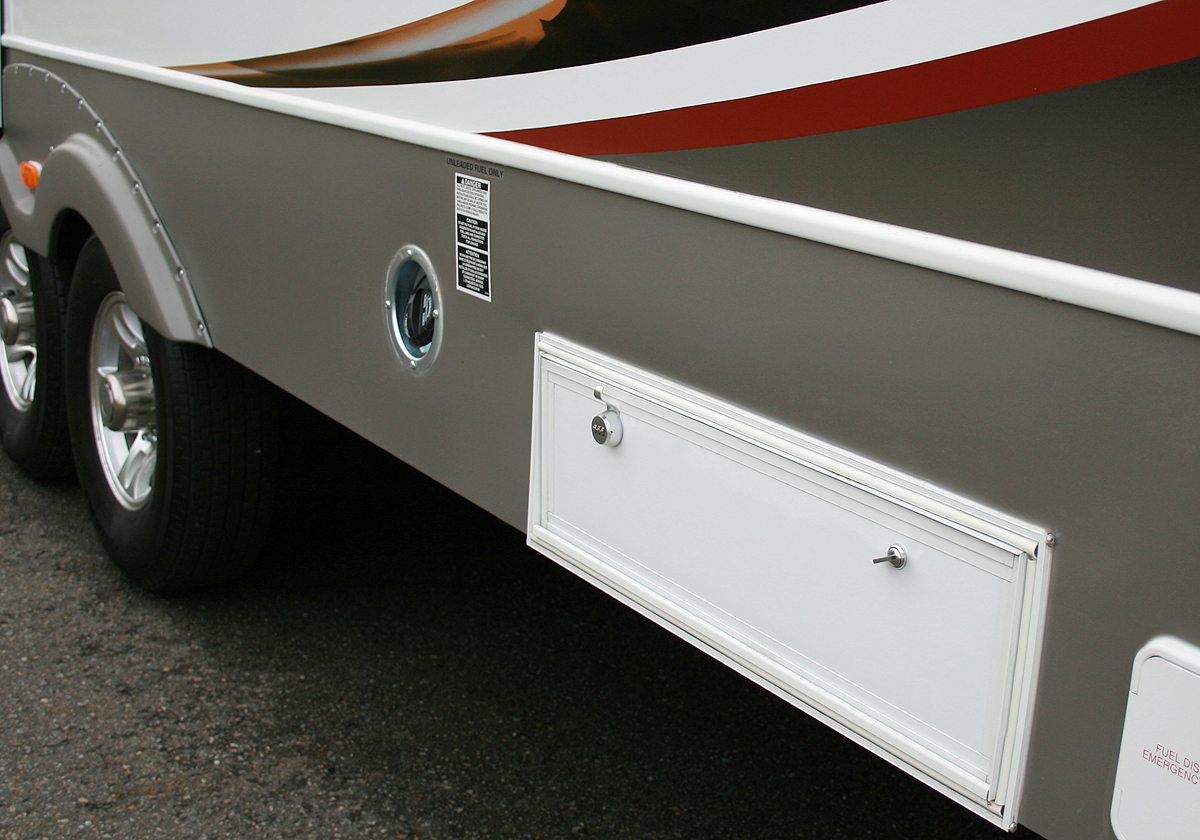
Surge Protector/EMS
Protect your RV electrical system with a surge protector or a more advanced form of it, EMS (electronic management system). These devices prevent damage to your onboard appliances from power surges, such as from lightning strikes or other anomalies.
An EMS will protect your electrical system from faulty wiring in high or low voltage scenarios. In essence, a surge protector is a fire alarm, and an EMS is the sprinkler system. We have shared everything you need to know about RV surge protectors in this previous article.
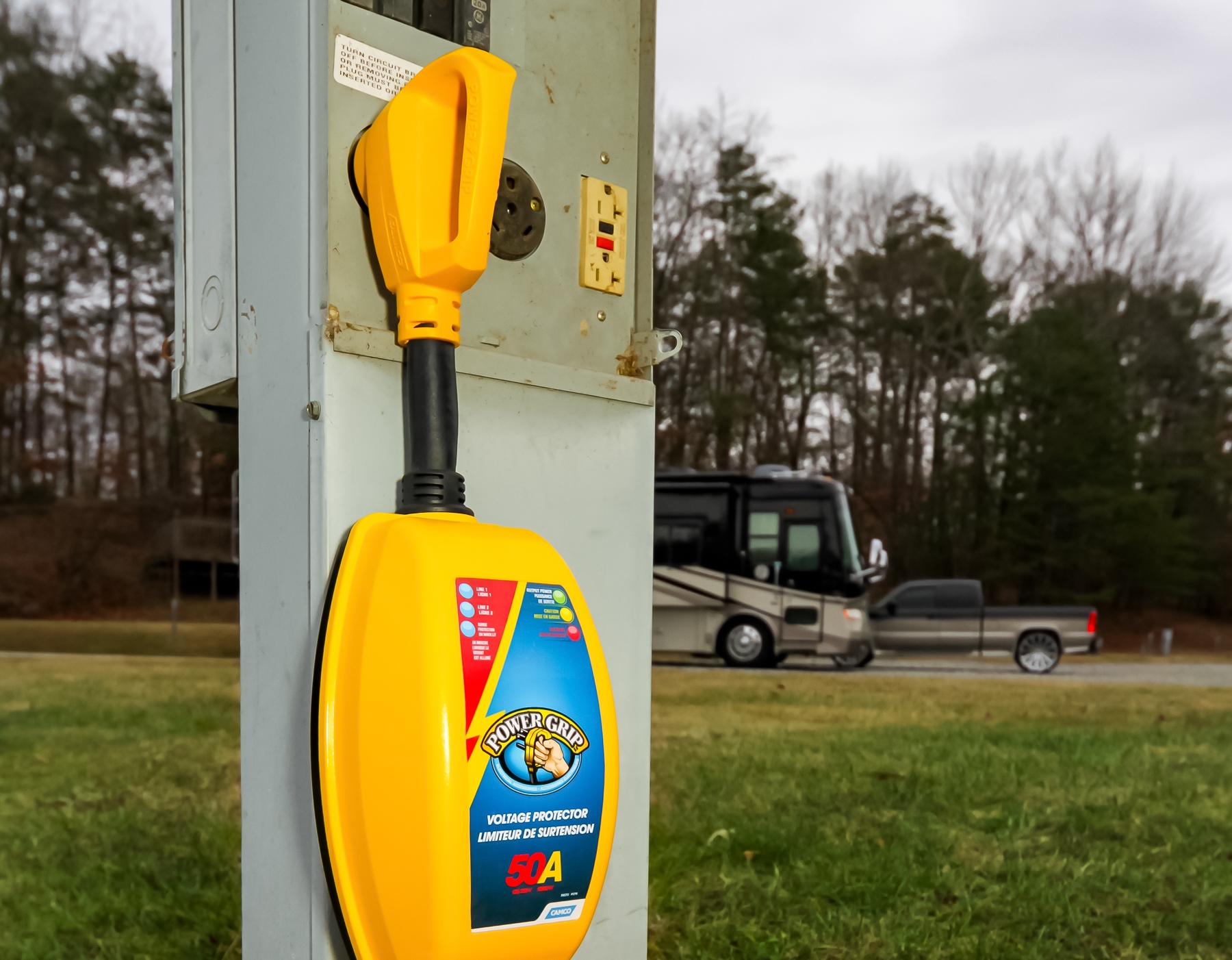
New Technology and Devices
Nowadays, technology makes the world go round, and our RV wheels continue to roll a bit further down the road. It is jaw-dropping to witness how it has evolved in such a short time and how it continues to make life on the road more comfortable and safe. The following are RV upgrades that are sure to add these features and more to your travel adventures.
Tire Pressure Monitoring System
Properly inflated tires will last longer and are less prone to blowouts. This RV upgrade could technically be placed under the category of safety, however, the mode of detecting tire pressure has experienced leaps and bounds in advancement.
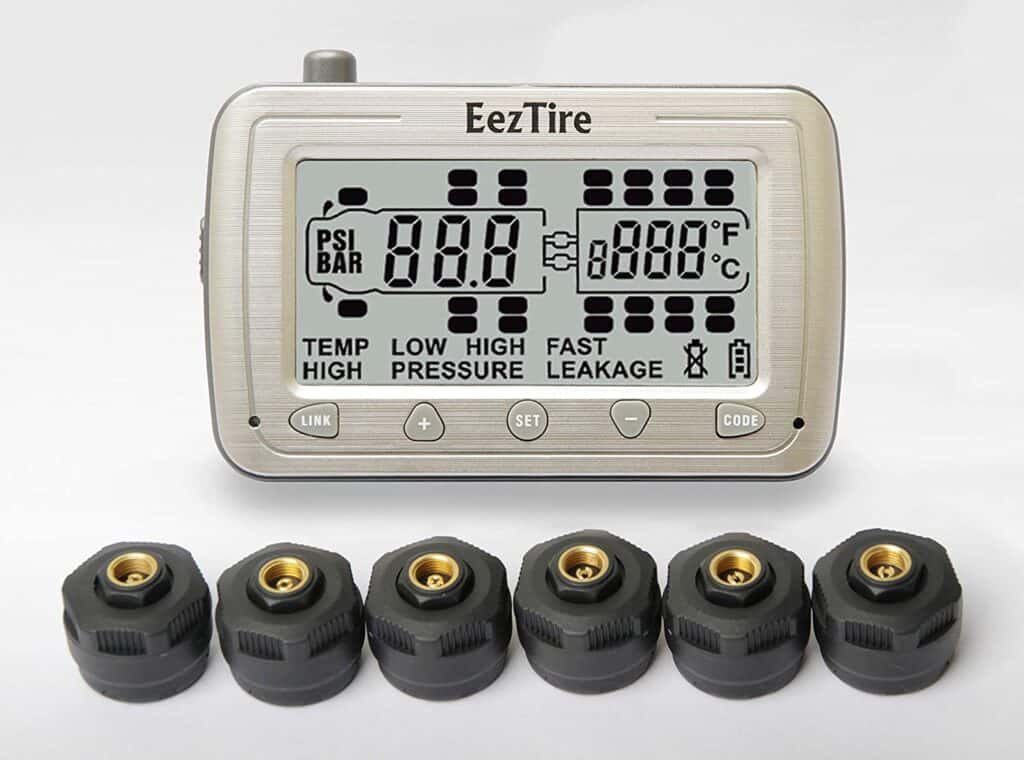
Once measured using a handheld gauge, tire pressure can now be monitored from your phone using Bluetooth. Monitoring systems like the EEZTire-TPMS6 Tire Pressure Monitoring System have sensors that screw on the stem of each. The sensors then submit information like pressure and temperature to your phone or a monitor in your towing vehicle.
Automatic Generator Start System
Even if you decide to have a solar power kit, it’s still a good idea to have a generator for those cloudy days and, of course, at night when your solar panels cannot collect energy. An automatic generator start system will start your generator if your battery gets below a designated charge. Some models can also be attached to a thermostat.
The generator automatically starts if a particular temperature is reached to turn on your RV air conditioner or heat pump. It connects to your generator and your batteries and monitors the voltage of your batteries. An automatic generator start is ideal for boondocking enthusiasts because it will minimize the use of your generator while maintaining the battery and/or keeping the optimal indoor temperature.
Cell Booster
If you work on the road or roadschool and rely on cell service for your work routine, investing in a cell booster is a definite necessity. Cell boosters like the WeBoost Drive X RV help RVers get online.
It boosts weak cell signals, including 4G and 5G signals. This allows you to connect in remote, out-of-the-way locations. Check out our full review of the WeBoost to learn more about the signal booster.
The following video from WeBoost gives the step-by-step process on how to install a cell phone signal booster in an RV.
Conserve Water Use
Do you and your traveling crew prefer boondocking in the wilderness over camping at RV parks? Resources like water are very precious and sometimes in limited supply with dry camping.
The amount of time that you can camp without hookups largely depends on your water supply. This supply includes how much freshwater you have available and the capacity of your grey and black water tanks. The following RV upgrades can certainly help prolong your stay in the great outdoors!
Water Tank Monitor System
RV tank sensors are not always accurate. False readings can be due to debris like toilet paper or food particles sticking to the sensors. If you are dry camping and limited on resources, it is a good idea to keep an eye on how much freshwater you still have available and what has been used.
Garnet has devised a product that allows RVers to accurately track their holding tanks usage with the SeeLevel II Model 709-BTP3 Tank Monitor. The system includes circuit boards or senders that attach to the outside of the different water tanks. A monitor records the fullness of each tank. Recordings can also be read from a smart device like your phone or tablet.
Showerheads and faucets
Making some adjustments to the plumbing can conserve water, specifically with showerheads and faucets. The amount of water that pours out of these parts can be minimized and even improve the streaming effect.
Use aerators on sink faucets to minimize water use but maximizing flow performance. Replace the original showerhead for one that is rated for high pressure without compromising water supply.
Learn more about RV Showerheads: Should You Make The Upgrade?
Composting Toilet
RV composting toilets eliminate the need for water altogether. Some RVers that have switched to this green latrine have ended up converting their black tank into an additional grey tank.
A composting toilet incorporates the principles of decomposition and, in some toilet models, evaporation to create a cleaner, environmentally-friendly output. The following video from Gone With the Wynns describes how to prep and dump a composting toilet.
Outside Showerhead
If you are wanting to use water outside for things like rinsing off after a dip in the lake or washing your dog, installing an outside showerhead is a convenient RV upgrade. Make sure to install a showerhead with low flow/high pressure to help save on water use.
Increase Storage Capacity
One of the biggest gripes from RVers is that there is never sufficient storage space, and the storage allotted doesn’t quite make for the most functional living. Luckily, there are tons of products on the market that offer a variety of storage choices.
External Mounts
A big part of RVing is venturing out into the outdoors and experiencing all it has to offer. If you are an avid outdoors sportsman, then it makes sense to take your toys along for the trip. Kayaks, bicycles, fishing equipment, oh my! Space inside an RV is already limited, so in this case, the only other place to find storage is outside the RV.
Mounting these items on their appropriate racks is an option. Another alternative is using a rear/cargo carrier to hold items like water jugs, a generator, or other bulky things you’d prefer not to carry indoors.
Indoor Storage Accessories
A simple Google search of “RV storage ideas” will produce all kinds of articles and blog posts like this one. Creating a space that allows you and your traveling crew to comfortably move around your RV sometimes means making some initial modifications. Installing mundane items like towel racks, Command hooks, spice racks, and extra shelving or cubbies can make a world of difference in your everyday RV living.
Update the Outdated RV
Older rigs can benefit from these RV upgrades. These DIY projects can completely transform a drab, outdated unit into a sought after dream on wheels. Some RVers purchase brand new RVs and still incorporate some of these upgrades for a more customized, comfortable fit.
New RV Mattress
A standard RV mattress is often a low-grade product meant more for show than comfort. Preserve precious sleep time and unnecessary visits to the chiropractor with a quality mattress or topper.
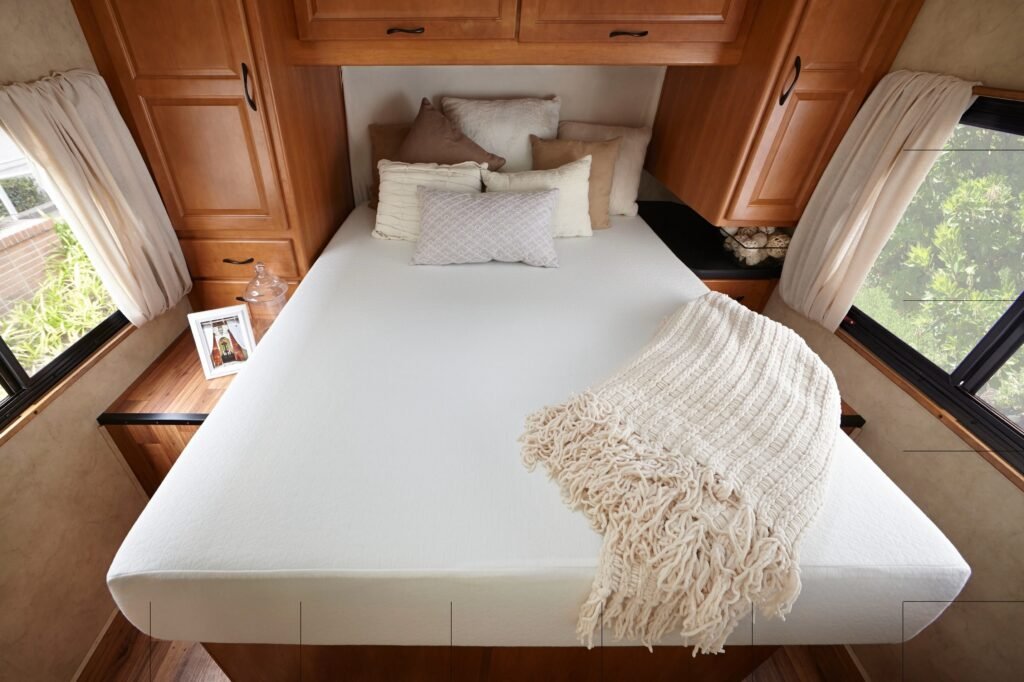
The one caveat in this shopping expedition is ensuring that the mattress fits the dimensions of the bed frame. RV mattresses are not the same as standard mattress sizes; they are smaller. Custom mattresses can be purchased at furniture stores or online. To help you in your search for your best sleep, RV LIFE lists some of the highest-rated RV mattresses in this article. You may also want to upgrade your RV bed sheets as well.
New Paint
A fresh coat of paint can completely change the look and feel of any space. Forgoing the most convenient but rather pricey option of hiring professionals? Join the growing number of RVers that are tackling the tedious task of painting their RV inside and out.
For interior paint jobs, the RV remodeling gurus at The Flipping Nomad suggest the following, “Clean everything with TSP (Trisodium phosphate), sand the wood, two coats of PPG Gripper primer and two coats of Behr Paint and Primer in One. Don’t sand the walls.”
RV exteriors take a beating on and off the road. UV rays fade colors and decals, hail storms can dent surfaces, and constant exposure to salty roads without proper rinsing off the RV increases the rate of rusting. RV Hometown’s article, How to Paint an RV Exterior, details the process in nine steps, including what products are needed, prepping the RV for coats, and ways to maintain the paint job.
Peel-and-stick Backsplash
A quick and easy way to add some flare to a drab background is with peel and stick backsplash. Peel and stick backsplash works like wallpaper, but it is less time consuming and has a simple application process.
Some backsplashes, like some peel and stick mosaics, come packaged in 10-by-10 inch vinyl tiles and require a wall wipe down before mounting. No grout required. They are typically showcased in kitchens and bathrooms not only for a pop of color, but they make clean-up easy since they can be wiped down and disinfected.
Peel and stick backsplashes come in many styles, are an inexpensive purchase, and hardly add any additional weight to your RV. Plus, they are removable, so you aren’t married to any one selection.
RV Flooring
Replacing old flooring can improve the look and comfort of your RV, and depending on the condition of the carpet, it can significantly decrease unpleasant smells and possible allergens. This is especially true with used RVs where previous owners smoked inside or traveled with pets.
Among the types of replacement flooring, NADAguides.com recommends vinyl over carpet, laminate, and hardwood. “It’s a versatile material, and you can find vinyl tiles, sheets, and planks with simple installation systems. Vinyl is durable and water-resistant. It’s easy to clean, which makes a significant difference in high-traffic areas.”
Learn how to replace your RV carpet with vinyl flooring in this article from Crazy Family Adventure.
RV Upgrades Galore
The RV industry, encompassing manufacturers and companies that specialize in RV accessories, are continuously upgrading and rethinking RV design and accommodations based on customer input and trending styles. This checklist of RV upgrades will inevitably grow as new innovations and conveniences develop.
Keep up with the latest RV models and gadgets via Camper Report. Learn about all kinds of ways you can upgrade your RV on iRV2 forums as well. RVers share their tips and tricks on all things RVing, especially personalizing an RV to meet travel needs and preferences. You can also browse RVUpgrades.com to find a wide variety of accessories on the market for all your camper needs.
See also: 5 Things To Buy (And 5 Things To Avoid) At The RV Supply Store

